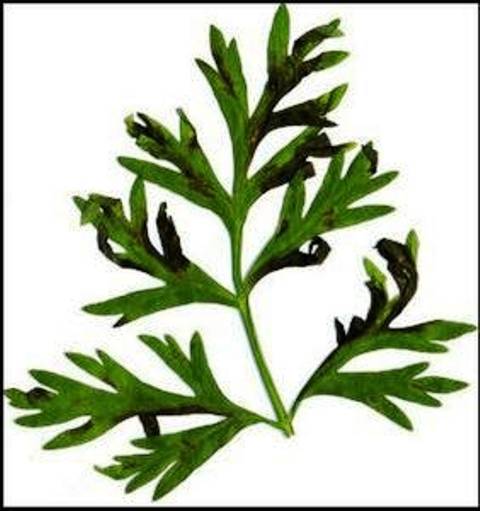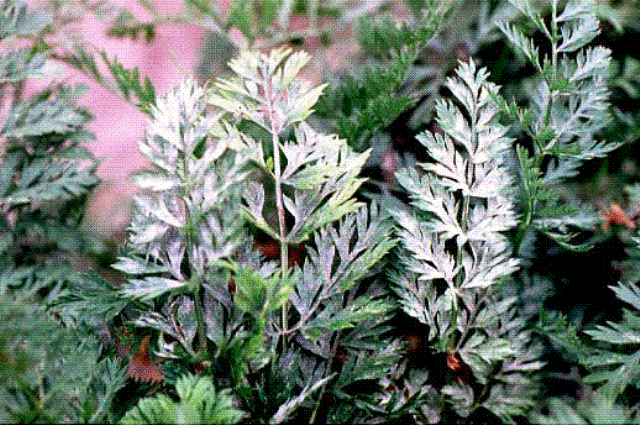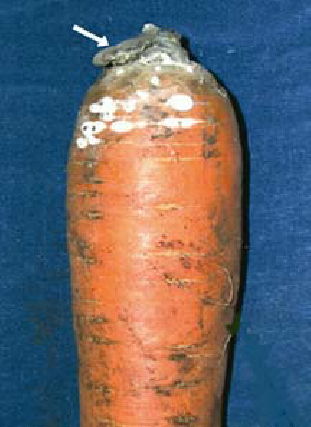
With a maturing period of close to 4 months (120 days) Carrots are grown from seed. With proper conditions, this time period can yet be reduced to 70 to 80 days. The optimum temperature for carrots to grow is 16 to 21 °C (61 to 70 °F). And the ideal soil should be deep, loose and well-drained, sandy or loamy, with a pH of 6.3 to 6.8. Since the crop requires low levels of nitrogen, moderate phosphate and high potash, proper and discriminated use of fertilizer should be there. Though “carrot” could be a profitable and high yielding crop, there are several diseases that can reduce the yield and market value of carrots. Some of the major diseases with their control mechanism, are sourced and suggested by the NHB, National Horticultural Board are here :
1. Cercospora Leaf Blight (Cercospora carotene) :
The disease produces severe blighting on carrot leaves and petioles if wet weather is prolonged during the growing season. Entire leaves and petioles may die on severely infected plants. The symptoms first appear along the margins of the leaves, often causing the leaves to curl. Spots inside the leaf edges are small, roughly circular, and tan or grey to brown with a dead centre. As the lesions increase in number and size, the entire leaflet withers and die. The fungus attacks younger leaves and plants in preference to older ones. In heavily infested fields, however, both older and younger leaves are subject to attack. The pathogen also produces lesions on the petioles and stems. The lesions may merge and girdle the stems, causing the leaves to die.

Control: The leaf blight pathogens can survive from one year to the next in infected plant debris. Therefore, a two-to-three-year rotation is recommended to allow for the natural decline in the pathogen population. The use of disease-free seed is strongly recommended because the fungus can survive on or in the seed. Early applications of Foltaf (0.2%), Copper Oxychloride (0.3%), starting at the first sign of infection, effectively control leaf blights on carrots. The best control is achieved when fungicides are applied at high pressure and in sufficient water to reach the lower leaves in a dense canopy.
2. Alternaria Blight (Alternaria dance):
Alternaria leaf spots first appear at the margin of the leaflets and are dark brown to black and irregular in shape. Lesions produced on the petioles and stems are dark brown and often coalesce and girdle the stems. As the disease progresses entire leaflets may shrivel and die, appearing scorched. Alternaria leaf lesions are generally more prevalent on older foliage and plants than on young foliage. The disease spreads rapidly on the older leaves of a maturing crop after the rows have closed. This is due in part to poor air circulation among the older lower leaves in the canopy and to the moisture-holding capacity of the dense foliage.

Control: The disease can be kept under check if a well-drained soil is selected and suitable crop rotation is adopted. Since the fungus can survive in the seed, hot water treatment at 50°C for 15 minutes is recommended. Seed treatment with Thiram (3g/kg of seed) before sowing is effective to control the disease. Crop rotation and destruction of infected plant material in the field will minimize the disease infection, Fungicidal applications with Foltaf (0.2%), Copper Oxychloride (0.3%) satisfactorily control the disease.
3. Powdery Mildew (Erysiphe polygons):
The symptoms appear as white powdery growth on the leaves and petioles causing the leaves to turn brown and wilt.

Control: Spraying Bavistin (0.1%) or Benlate (0.1%) at an interval of 8-10 days effectively controls the disease.
4. Watery soft rot (Sclerotinia sclerotiorum):
Carrots are susceptible to this disease, especially late in the season and during storage. The disease is present in soil or storage areas and often shows up after the crop has been harvested. Symptoms can be identified in the field as a characteristic white mould with black sclerotia present on the crown of infected carrots. In storage, a soft, watery rot with white mold and black sclerotia characterizes the disease.

Control: Crop rotation, weed control (to improve air circulation), planting on raised beds, winter flooding, rapid cooling prior to storage and meticulous sanitation of all storage components are all necessary to reduce losses from this disease.
5. Black Rot (Alternaria radical):
This disease can be seed and soil-borne and is characterized by a shiny black decay at the crown area and a greenish-black mould on the taproot. The infected tissue is greenish-black to jet black due to the presence of masses of black spores. This disease affects the roots in the field as well as in storage.

Control: Proper field sanitation and practising rotation help to keep the disease under control. The 0 root surface should be kept dry and stored at 0 C with 95 % relative humidity.
6. Bacterial soft Rot (Erwinia carotovora p.v. carotovora and Erwinia carotovora p.v.atroseptica):
Bacterial soft rots of carrots occur only when soil conditions are wet or storage conditions are poor. Soft water-soaked, irregular lesions appear on the roots. Initially, these lesions are superficial but soon spread to cover the inner tissues. The foliage may remain green until the disease on the tuber advances considerably. The entire plant wilts when complete rotting of the tuber takes place. A foul odour is given out from the decayed roots. Abundant moisture on the root surface favours disease incidence.

Control: Planting on raised beds in poorly drained areas may also reduce bacterial infections. Careful harvest handling, grading and sanitation are the only ways to reduce the problem. The diseased roots should not be stored along with the healthy tubers. The root surface should keep dry 0 and stored at 0 C with 95 % relative humidity.
7. Carrot Yellows
The affected leaves become yellow accompanied by vein clearing. Dormant buds in the crown grow out into chlorotic shoots, which give a withers broom appearance on the top. Size and quality of roots are reduced and malformed. The internal texture of roots shows marked changes causing a reduction in value carrots for fresh market as well as for processing. Roots of infected plants have a bitter taste with astringent flavour. The disease is transmitted by the six-spotted leaf hopper.

Control: Weed control especially of those acting as alternate host eliminates the disease. Spraying insecticides to control the leaf hopper population helps to reduce the disease attack.
















